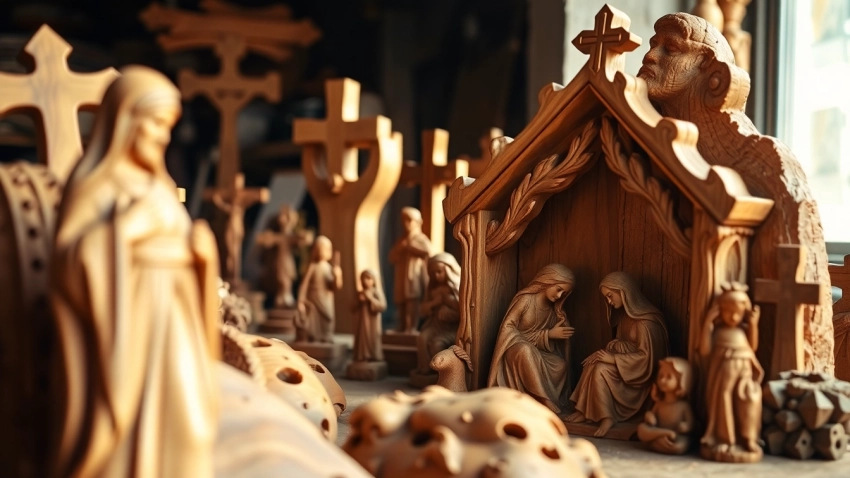
Why Olive Wood Carvings Are Treasured Artifacts of the Holy Land
The Artistry Behind Olive Wood Carvings
Olive wood carvings have captured the hearts of art enthusiasts and collectors worldwide. This distinctive art form, originating from the ancient olive trees of the Mediterranean region, particularly Bethlehem and Jerusalem, showcases the remarkable skills of local artisans. Olive wood carvings not only serve as beautiful decor items but also embody deep cultural significance and a rich historical context. In this article, we delve into the artistry behind olive wood carvings, their various types, how to purchase them wisely, their impact on local communities, and tips for expanding your own collection.
History of Olive Wood Carving
The tradition of olive wood carving dates back centuries, deeply interwoven with the cultural and religious heritage of the Holy Land. Ancient civilizations recognized the value of the olive tree not only as a source of sustenance but also as a symbol of peace and longevity. Olive trees can live for hundreds, even thousands of years, making wood from these trees a highly prized material for artisans. Historically, olive wood carvings have been associated with Christian religious art, especially in depicting nativity scenes and religious figures.
Techniques Used by Artisans
Artisans in the Holy Land employ traditional techniques that have been passed down through generations. This craftsmanship requires immense skill and patience, as the intricate details of the carvings often take weeks to complete. Many artisans work with hand tools, carefully chiseling and shaping the wood to achieve detailed textures and forms. The distinct grains and colors of olive wood add to the uniqueness of each piece, ensuring that no two items are ever identical. Some techniques may also involve the addition of other materials, such as mother-of-pearl, to enhance the visual appeal of the carvings.
Cultural Significance of Olive Wood Art
Beyond their aesthetic appeal, olive wood carvings are steeped in cultural significance. For many Christians, these carvings serve as a tangible connection to their faith. Statues of saints, crucifixes, and especially nativity scenes are commonly used in homes and churches, reminding the faithful of their religious heritage. Furthermore, the act of purchasing olive wood carvings supports local artisans and preserves traditional crafts that might otherwise be lost to modern mass production.
Types of Olive Wood Carvings
Nativity Scenes and Religious Symbols
Nativity scenes are perhaps the most recognizable form of olive wood carvings. These intricate depictions of the birth of Jesus often feature detailed figures of Mary, Joseph, and baby Jesus, along with animals, angels, and the setting itself. Many artisans create stunningly realistic figures that reflect the deep spirituality and reverence of this pivotal event in Christian tradition. Other religious symbols, such as crucifixes and angels, also hold significant value and are commonly found in many households as a part of personal devotion.
Decorative Objects and Home Accents
Aside from religious carvings, there is a diverse array of decorative objects made from olive wood. These can include bowls, serving plates, coasters, and various ornaments that add a rustic charm to any home decor. The natural beauty of olive wood, with its rich hues and unique grain patterns, makes each piece a conversation starter. Decorative carvings may also take forms like small animals or trees, showcasing the artisan’s creativity and craftsmanship.
Custom and Personalized Carvings
For those looking for something unique, custom and personalized olive wood carvings are an excellent option. Many artisans offer the ability to create bespoke pieces, whether it’s a unique statue, a nameplate, or a personalized gift for special occasions. Custom carvings not only add sentimental value but also support the local economy by providing artisans with additional opportunities to showcase their distinctive skill sets.
Buying Olive Wood Carvings: What You Need to Know
Authenticity and Ethical Sourcing
When purchasing olive wood carvings, it is crucial to consider authenticity and ethical sourcing. Many artisans in Bethlehem and Jerusalem have been affected by political and economic challenges, making it essential to buy from reputable sources that support these communities. Look for sellers who provide information about the origin of the wood and the craftsmanship behind each piece. Authentic olive wood carvings will often have a unique grain pattern and a natural feel that speaks to the quality of the material used.
Tips for Selecting Quality Carvings
Choosing high-quality olive wood carvings requires an eye for detail. Here are some tips to guide your selection:
- Inspect the carving: Look for intricate details and a smooth finish. Quality work will typically exhibit fine craftsmanship without any rough edges.
- Check the grain: Authentic olive wood displays distinctive patterns. Ensure there are no synthetic finishes that could detract from its natural beauty.
- Ask about the artisans: Knowledge about the artisans who created the piece can lend credibility to its quality. This can also enhance your appreciation for the art.
Caring for Your Olive Wood Pieces
To maintain the beauty and longevity of your olive wood carvings, proper care is essential:
- Avoid soaking: Never soak your olive wood pieces in water. Instead, wipe them clean with a damp cloth.
- Dry promptly: After cleaning, dry your pieces thoroughly to prevent any moisture retention.
- Use mineral oil: Regularly apply food-safe mineral oil to keep the wood nourished and prevent cracking or drying out.
The Impact of Olive Wood Carving on Local Communities
Supporting Local Artisans in Bethlehem
The olive wood carving industry provides a vital source of income for many families in Bethlehem. By purchasing these carvings, consumers contribute to the livelihoods of local artisans who often rely entirely on their craftsmanship. This support helps sustain their families and promote the continuity of traditional art forms that define their cultural heritage.
Economic Benefits of Olive Wood Carving Industry
Beyond individual artisans, the olive wood carving industry significantly contributes to the local economy. The influx of tourism in Bethlehem creates a market for these unique wood products, fostering economic development. Many artisans also collaborate with various local businesses, creating a network that supports not just the arts but the overall economic health of the region.
Preserving Cultural Heritage through Art
Olive wood carving is more than an art form; it is a direct link to the cultural heritage of the Holy Land. By preserving these age-old techniques and promoting these crafts, communities can uphold their traditions and showcase their rich history to the world. Initiatives that promote workshops and exhibitions further encourage engagement between artisans and interested consumers, deepening the appreciation for this art.
Expanding Your Collection of Olive Wood Carvings
Popular Online Retailers for Olive Wood Crafts
In the digital age, acquiring olive wood carvings has never been easier. A number of online retailers offer extensive collections, making it possible to find a wide range of authentic products from the comfort of home. Notable retailers include local artisan marketplaces and specialized stores that focus solely on items from the Holy Land. Always verify that these retailers adhere to ethical standards and authenticity to ensure you’re supporting the artisans appropriately.
Craft Fairs and Artisan Markets
Attending craft fairs and artisan markets can be an excellent way to discover unique olive wood pieces. These events often showcase local talent and provide a space for artisans to present their work. Not only will you find authentic pieces, but you also have the opportunity to interact with the artisans, adding a personal connection to your purchase.
Incorporating Olive Wood Carvings into Your Home Decor
Olive wood carvings can enhance the aesthetic appeal of any home. Whether displayed prominently on a mantelpiece or used as subtle decor elements throughout your space, these pieces add warmth and a rich story to your home’s environment. Consider combinations of different items—such as a nativity scene paired with decorative bowls or sculptures—to create a cohesive look that resonates with your personal style.












Leave a Reply